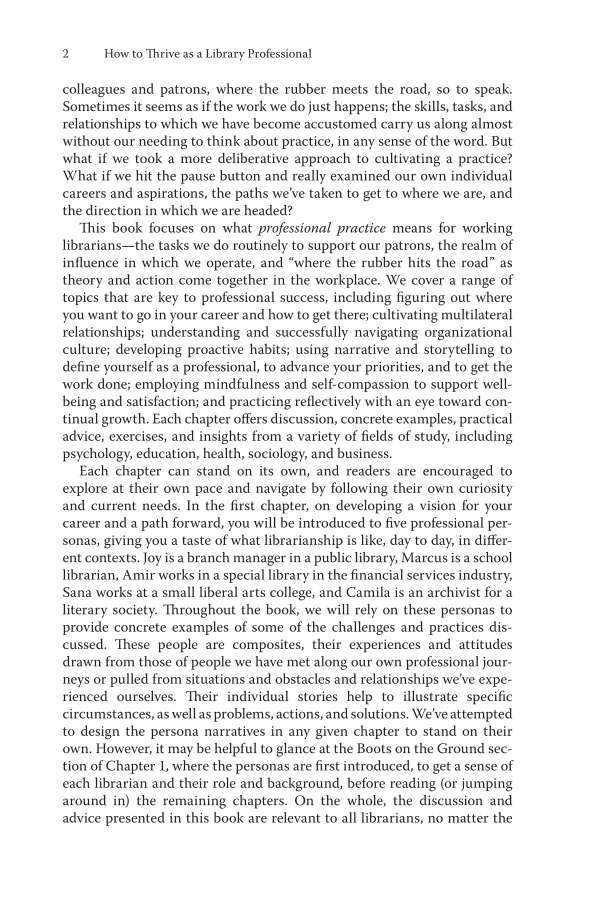2 How to Thrive as a Library Professional colleagues and patrons, where the rubber meets the road, so to speak. Sometimes it seems as if the work we do just happens the skills, tasks, and relationships to which we have become accustomed carry us along almost without our needing to think about practice, in any sense of the word. But what if we took a more deliberative approach to cultivating a practice? What if we hit the pause button and really examined our own individual careers and aspirations, the paths we’ve taken to get to where we are, and the direction in which we are headed? This book focuses on what professional practice means for working librarians—the tasks we do routinely to support our patrons, the realm of influence in which we operate, and “where the rubber hits the road” as theory and action come together in the workplace. We cover a range of topics that are key to professional success, including figuring out where you want to go in your career and how to get there cultivating multilateral relationships understanding and successfully navigating organizational culture developing proactive habits using narrative and storytelling to define yourself as a professional, to advance your priorities, and to get the work done employing mindfulness and self-compassion to support well- being and satisfaction and practicing reflectively with an eye toward con- tinual growth. Each chapter offers discussion, concrete examples, practical advice, exercises, and insights from a variety of fields of study, including psychology, education, health, sociology, and business. Each chapter can stand on its own, and readers are encouraged to explore at their own pace and navigate by following their own curiosity and current needs. In the first chapter, on developing a vision for your career and a path forward, you will be introduced to five professional per- sonas, giving you a taste of what librarianship is like, day to day, in differ- ent contexts. Joy is a branch manager in a public library, Marcus is a school librarian, Amir works in a special library in the financial services industry, Sana works at a small liberal arts college, and Camila is an archivist for a literary society. Throughout the book, we will rely on these personas to provide concrete examples of some of the challenges and practices dis- cussed. These people are composites, their experiences and attitudes drawn from those of people we have met along our own professional jour- neys or pulled from situations and obstacles and relationships we’ve expe- rienced ourselves. Their individual stories help to illustrate specific circumstances, as well as problems, actions, and solutions. We’ve attempted to design the persona narratives in any given chapter to stand on their own. However, it may be helpful to glance at the Boots on the Ground sec- tion of Chapter 1, where the personas are first introduced, to get a sense of each librarian and their role and background, before reading (or jumping around in) the remaining chapters. On the whole, the discussion and advice presented in this book are relevant to all librarians, no matter the
Document Details My Account Print multiple pages
Print
You have printed 0 times in the last 24 hours.
Your print count will reset on at .
You may print 0 more time(s) before then.
You may print a maximum of 0 pages at a time.
















































































































































